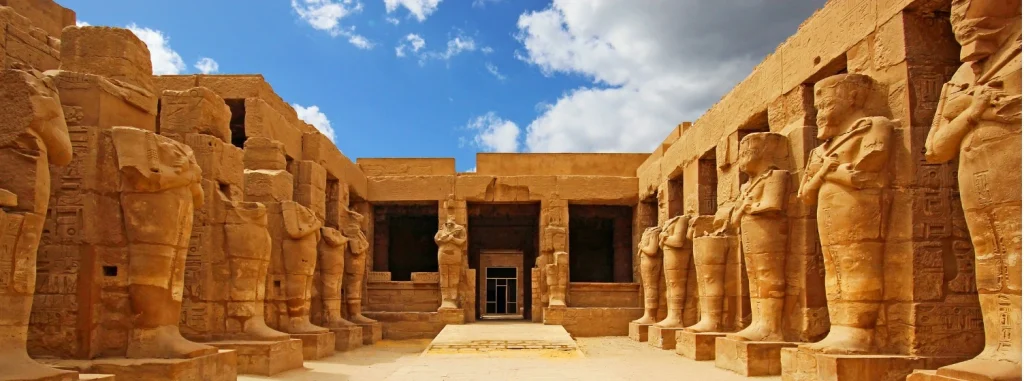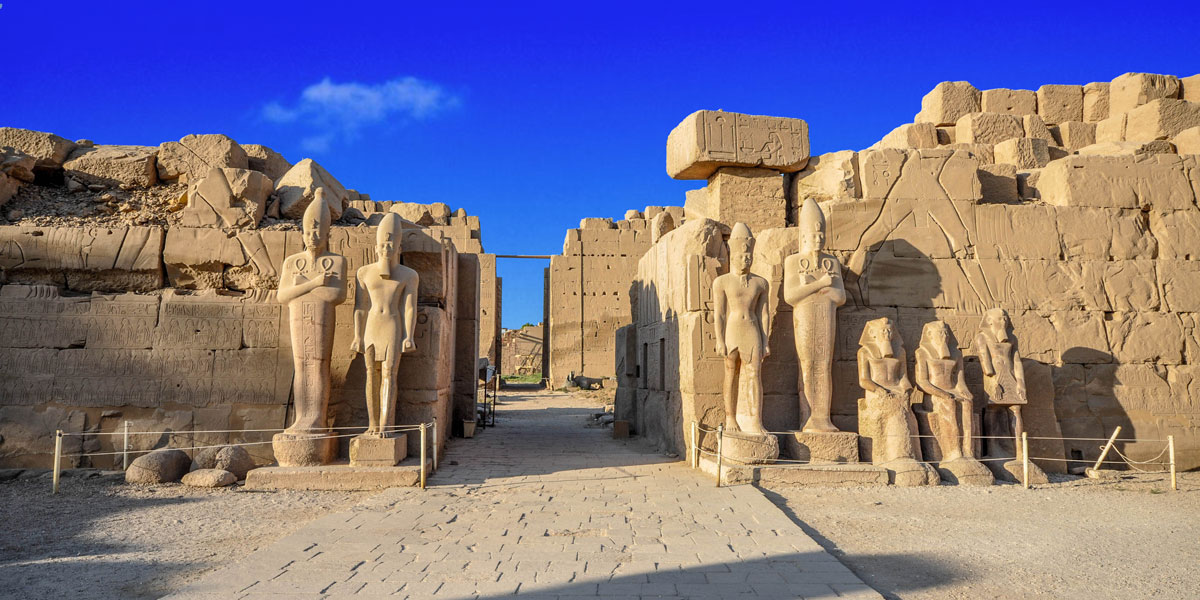Karnak Temple: Unveiling the Grandeur of Ancient Egypt’s Sacred Site

Step into the enchanting world of ancient Egypt as you explore the magnificent Karnak Temple, a symbol of grandeur and religious devotion. Located on the eastern bank of the Nile River in Luxor, Egypt, this sacred site was dedicated to the worship of the ancient Egyptian gods and goddesses.
With its colossal columns, intricately carved reliefs, and vast hypostyle hall, Karnak Temple is a testament to the architectural prowess and artistic sophistication of the ancient Egyptians. The sheer scale and detail of the temple complex are awe-inspiring, transporting visitors back in time to a civilization that flourished thousands of years ago.
As you stroll through the temple grounds, you’ll discover the Hypostyle Hall, with its forest of towering columns, and marvel at the iconic obelisks that reach toward the sky. Among the most impressive structures is the Great Hypostyle Hall, featuring 134 columns, each towering over 60 feet high. On the walls, intricate carvings tell stories of ancient mythology and pharaonic conquests, providing a fascinating glimpse into the beliefs and history of this ancient civilization.
Experience the wonder of Karnak Temple and immerse yourself in the rich tapestry of ancient Egyptian history and culture. Explore its awe-inspiring ruins, embrace the mystery of its sacred spaces, and unlock the secrets of a bygone era.
History and Significance of Karnak Temple
Karnak Temple’s history stretches back over 4,000 years, making it one of the most significant religious complexes in ancient Egypt. Initially constructed during the Middle Kingdom, its expansion continued through the New Kingdom, particularly under the reigns of some of Egypt’s most powerful pharaohs, including Ramses II and Hatshepsut. The temple served as a major center for the worship of Amun-Ra, the king of the gods, signifying its importance in the pantheon of ancient Egyptian spirituality.
The significance of Karnak extends beyond religion; it served as a political and cultural hub as well. Pharaohs would often commemorate their victories and achievements by adorning the temple walls with detailed inscriptions and impressive reliefs. These artworks not only displayed the might of the rulers but also solidified their divine right to govern, intertwining the realm of politics with the divine.
Throughout various periods, Karnak Temple witnessed significant historical events, including festivals and ceremonies that celebrated the flooding of the Nile and the agricultural cycles. The Opet Festival, in particular, was a grand event where the god Amun was paraded from Karnak to Luxor Temple, reinforcing the connection between the gods and the pharaohs. This blend of religious fervor and political significance makes Karnak a landmark of ancient Egyptian civilization.
Architecture and Layout of Karnak Temple
The architecture of Karnak Temple is a brilliant manifestation of ancient Egyptian engineering and artistry. The temple complex covers an area of approximately 200 acres, making it one of the largest religious sites in the world. It consists of numerous temples, chapels, and pylons, each meticulously designed to honor various deities. The layout of the temple is organized in a way that reflects the ancient Egyptian worldview, with a central axis leading from the entrance to the most sacred areas.
As visitors enter the temple, they are greeted by a massive pylon, a monumental gateway that marks the transition from the secular world to the sacred. The walls of the pylon are adorned with vibrant hieroglyphics and scenes that depict the pharaoh’s accomplishments. Beyond the pylon lies a series of courtyards and sanctuaries, each dedicated to different gods. The careful placement of these structures creates a sense of journey, guiding worshippers through a sacred space designed to inspire reverence and awe.
The use of columns is one of the most striking features of Karnak Temple’s architecture. The columns are not only functional but also serve as artistic expression. Each column is intricately carved with hieroglyphs and depictions of gods, animals, and floral motifs, showcasing the exceptional skill of ancient artisans. The sheer height and number of these columns create an overwhelming sense of grandeur, illustrating the temple’s importance as a place of worship and celebration.
The Great Hypostyle Hall: A Marvel of Ancient Engineering
One of the most iconic sections of Karnak Temple is the Great Hypostyle Hall, a masterpiece that exemplifies ancient Egyptian architectural ingenuity. Spanning an area of over 50,000 square feet, this hall is supported by 134 colossal columns, some reaching a height of 69 feet. The sheer scale and craftsmanship of the hall have made it a focal point for visitors, drawing admiration and reverence from all who enter.
The design of the Great Hypostyle Hall is particularly noteworthy. The columns are arranged in a grid pattern, creating a sense of order and symmetry. The central aisle is flanked by taller columns, allowing natural light to filter through the clerestory windows, illuminating the intricate carvings and hieroglyphics that adorn the surfaces. This clever architectural technique not only enhances the visual experience but also symbolizes the connection between earth and the heavens, a core belief in ancient Egyptian cosmology.
The hall was not merely a structural marvel; it served as a crucial space for rituals and ceremonies. It was here that priests conducted sacred rites, invoking the blessings of the gods and ensuring the prosperity of the kingdom. The walls of the hall are covered in detailed reliefs that depict scenes of the pharaoh receiving offerings from the gods, emphasizing the divine nature of kingship. This combination of architectural brilliance and spiritual significance makes the Great Hypostyle Hall a true wonder of the ancient world.

Sacred Rituals and Ceremonies at Karnak Temple
Karnak Temple was a vibrant center of religious activity, where sacred rituals and ceremonies took place throughout the year. The temple complex was dedicated primarily to Amun-Ra, but other deities such as Mut and Khonsu were also honored within its walls. Various festivals were celebrated, each with its own unique rituals that played a vital role in the spiritual life of ancient Egyptians.
One of the most significant ceremonies was the Opet Festival, held annually to celebrate the flooding of the Nile and the fertility it brought to the land. During this festival, the statue of Amun was paraded from Karnak to Luxor Temple, accompanied by music, dancing, and offerings from the people. This grand procession symbolized the divine union between the pharaoh and the gods, reinforcing the legitimacy of the ruler and the prosperity of the kingdom.
In addition to grand festivals, daily rituals were integral to the functioning of the temple. Priests performed morning offerings to the gods, including food, incense, and music, ensuring that the deities were appeased and the cosmic order maintained. These rituals were steeped in symbolism, serving to connect the earthly realm with the divine. The meticulous care with which these rituals were conducted highlights the deep spiritual beliefs of the ancient Egyptians and their understanding of the importance of maintaining harmony with the gods.
Famous Monuments and Structures Within Karnak Temple
Karnak Temple is home to numerous monuments and structures that reflect the grandeur of ancient Egyptian architecture and religious devotion. Among the most notable is the Sacred Lake, a serene expanse of water that served a dual purpose. It was not only a place for ritual purification but also symbolized the primordial waters of creation. The lake is surrounded by beautiful porticoes and is often visited by tourists seeking a moment of reflection amidst the historical splendor.
Another remarkable feature is the Avenue of Sphinxes, a grand pathway lined with sphinx statues that once connected Karnak Temple to Luxor Temple. These sphinxes, with the body of a lion and the head of a pharaoh, were believed to protect the sanctity of the temple grounds. The avenue serves as a testament to the artistry of ancient craftsmen and the significance of the connection between the two temples, highlighting the religious and cultural continuity of the ancient Egyptian civilization.
Additionally, the temple complex boasts several obelisks, towering structures that symbolize the connection between the earth and the heavens. The largest of these is the Great Obelisk of Hatshepsut, standing at over 97 feet tall. These obelisks were often inscribed with hieroglyphs that celebrated the achievements of the pharaohs, serving as both monuments and spiritual markers within the sacred landscape of Karnak. The presence of these structures adds to the complex’s aura of majesty and divinity, inviting visitors to contemplate the profound spiritual beliefs of the ancient Egyptians.
Karnak Temple in Popular Culture and Media
The allure of Karnak Temple has transcended time, capturing the imagination of artists, filmmakers, and historians alike. Its majestic ruins have served as a backdrop for numerous films and documentaries that seek to illustrate the grandeur and mystery of ancient Egypt. Movies like “The Mummy” and various documentaries have showcased the temple’s breathtaking architecture, sparking a renewed interest in Egyptology and the ancient world.
In addition to film, Karnak Temple has inspired artistic interpretations across various mediums. Painters and sculptors have drawn from its intricate carvings and monumental structures, creating works that celebrate the beauty and complexity of ancient Egyptian culture. The temple’s imagery often evokes themes of divinity, power, and the eternal, resonating deeply with viewers and reinforcing the temple’s status as a symbol of ancient greatness.
Moreover, the temple complex has become a focal point for scholarly research and archaeological exploration. As researchers continue to uncover the secrets of Karnak, their findings contribute to our understanding of ancient Egyptian society, religion, and engineering. The temple’s enduring presence in both academic and popular contexts underscores its significance as a cultural landmark, inviting people from around the world to engage with the legacy of one of humanity’s oldest civilizations.
Tips for Visiting Karnak Temple
Visiting Karnak Temple is an unforgettable experience, but to make the most of your journey, a bit of planning is essential. First and foremost, consider the time of year you wish to visit. The peak tourist season runs from October to April when the weather is cooler and more comfortable for exploring the vast temple grounds. However, if you prefer a quieter experience, visiting during the shoulder seasons may provide a less crowded atmosphere.
When you arrive, take your time to explore the temple complex. A guided tour can enhance your understanding of the site, as knowledgeable guides can share insights into the history, architecture, and significance of various structures. Alternatively, you may opt for a self-guided visit, allowing you to wander at your own pace and spend time at the areas that captivate you the most. Don’t forget to bring a camera, as the stunning views and intricate details of the temple provide countless opportunities for memorable photographs.
Additionally, be prepared for the sun, as much of your visit will take place outdoors. Wear comfortable clothing, sturdy shoes, and plenty of sunscreen. Bringing water and snacks is also advisable, as exploring the extensive grounds can be tiring. Lastly, consider visiting during the early morning or late afternoon to experience the temple bathed in golden light, enhancing the beauty of the ancient stones and carvings.
Preservation and Ongoing Research at Karnak Temple
The preservation of Karnak Temple is a critical endeavor, as the site faces various challenges due to the passage of time and environmental factors. Efforts to protect and conserve the temple complex have been ongoing for decades, involving both local and international organizations dedicated to preserving Egypt’s rich cultural heritage. These initiatives aim to restore damaged structures, maintain the integrity of the carvings, and ensure that future generations can experience the awe of Karnak Temple.
Ongoing archaeological research continues to unveil new findings at Karnak, shedding light on the complexities of ancient Egyptian society. Excavations have revealed hidden chambers, remnants of rituals, and artifacts that provide deeper insights into the daily lives of the people who worshipped within these walls. Scholars and archaeologists are actively studying these discoveries, contributing to the broader understanding of ancient Egyptian history and culture.
Moreover, the use of modern technology, such as 3D imaging and drone surveys, is revolutionizing the way researchers approach the site. These innovative methods allow for detailed documentation of the temple complex, enabling more effective conservation strategies and enhancing our understanding of its architectural features. The commitment to preserving Karnak Temple and advancing research ensures that this magnificent site will continue to inspire and educate visitors for generations to come.
The Enduring Legacy of Karnak Temple
Karnak Temple stands as a monumental testament to the grandeur and spiritual depth of ancient Egyptian civilization. Its breathtaking architecture, rich history, and cultural significance resonate with visitors from around the world, inviting them to explore the mysteries of a bygone era. The temple’s ability to inspire awe and contemplation highlights the enduring legacy of the ancient Egyptians and their profound connection to the divine.
As we reflect on the stories etched into the temple walls and the rituals once performed within its sacred spaces, we gain insight into the values and beliefs that shaped one of history’s most remarkable civilizations. The ongoing preservation and research initiatives further underscore the importance of safeguarding this heritage, ensuring that future generations can continue to connect with the past.
Whether you are an avid historian, an architecture enthusiast, or simply a curious traveler, a visit to Karnak Temple promises to be a transformative experience. As you wander through its monumental halls and marvel at the artistry of ancient craftsmen, you become part of a rich tapestry that spans thousands of years—an invitation to engage with the timeless allure of ancient Egypt.
Also read: Fushimi Inari Shrine: Journey Through Kyoto’s Iconic Red Gates

